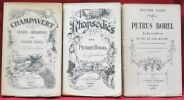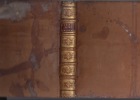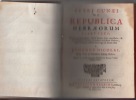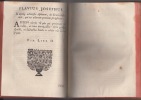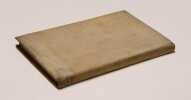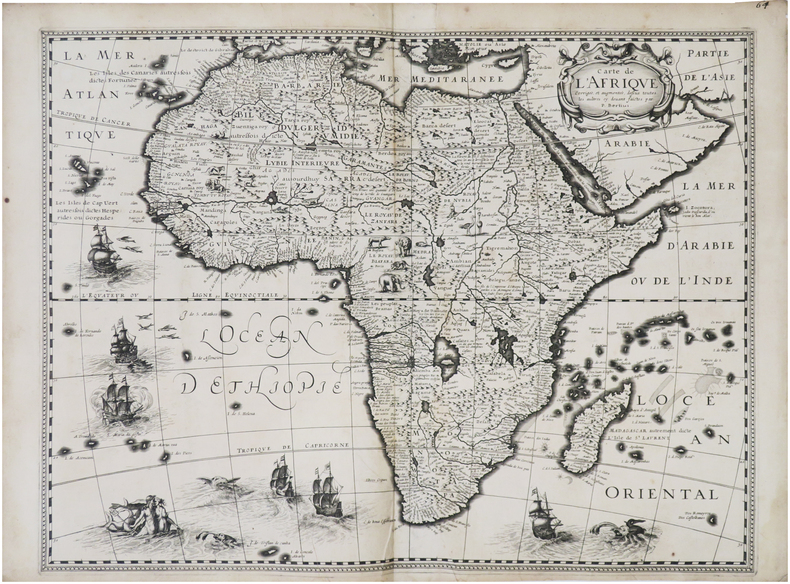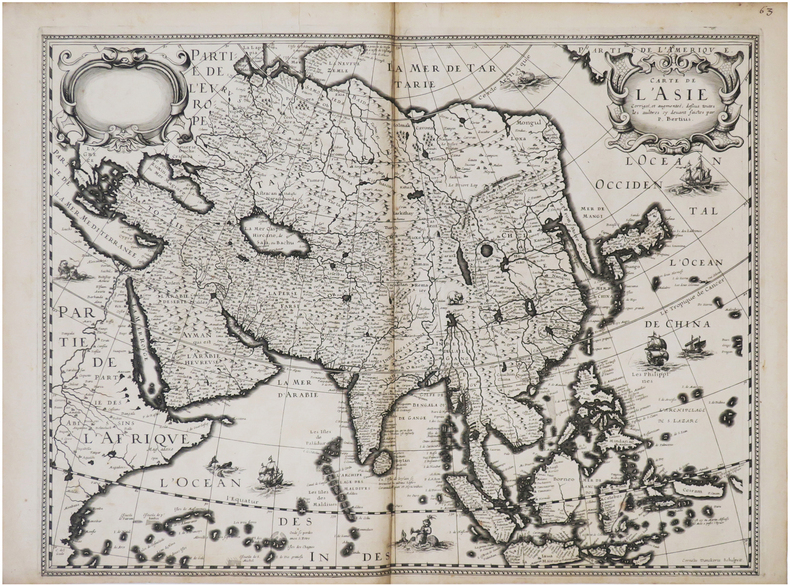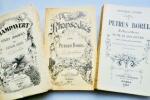718 books for « j petrus »Edit
-
Type
Book (706)
Magazine (1)
Maps (5)
Music sheets (6)
-
Latest
Last 24h (2)
Last 3 days (1)
Last month (21)
Last week (1)
-
Language
Dutch (5)
French (703)
Greek (2)
Latin (7)
Russian (1)
-
Century
16th (14)
17th (22)
18th (38)
19th (94)
20th (285)
21st (7)
-
Countries
Belgium (259)
Canada (1)
China (1)
Denmark (14)
France (367)
Germany (3)
Italy (2)
Netherlands (17)
Switzerland (53)
United States of America (1)
-
Syndicate
ALAC (1)
CLAM (9)
CNE (1)
ILAB (267)
NVVA (28)
SLACES (28)
SLAM (208)
Topics
- Acker (2)
- Antwerp (2)
- Archaeology (4)
- Architecture (16)
- Aristotle (4)
- Atlas (2)
- Balzac honoré de (6)
- Belgium (25)
- Bible (28)
- Bibliography (26)
- Biography (7)
- Boccaccio (3)
- Borel pètrus (33)
- Botany (3)
- Byzantium, (4)
- Cap (2)
- Cartography (2)
- Catholicism (5)
- Children’s books (10)
- Christianity (2)
- Christology (3)
- Churches (2)
- Communism (2)
- Dedication (4)
- Dictionaries (5)
- Dressmaking (31)
- Early printed books (6)
- Embroidery (12)
- Esotericism (2)
- Essays (2)
- Ethic (10)
- Europe (3)
- Exegesis (3)
- Fantastic (2)
- First edition (10)
- Forez (10)
- From lyons (4)
- Geography (3)
- Germanic languages (4)
- Germany (6)
- Greek (4)
- Hagiography (4)
- Hebraic literature (5)
- Helvética (5)
- History (52)
- Holland (3)
- Humanism (3)
- Ireland (3)
- Italy (3)
- Jesuits (5)
- Latin (110)
- Law (14)
- Linguistics (4)
- Linnean society of lyons (3)
- Literature (36)
- Liturgy (8)
- Logic (2)
- Lyons and area (3)
- Lyons college (3)
- Lyons college pc (3)
- Lyons revue (3)
- Magazine (5)
- Magnetism (3)
- Manuscripts (3)
- Maps (5)
- Mariology (7)
- Medicine (5)
- Military arts (2)
- Newspapers press (8)
- Patrology (5)
- Philosophy (14)
- Physics (2)
- Poetry (6)
- Portraits (3)
- Professions guilds (6)
- Public sale (10)
- Regionalism (5)
- Religions (44)
- Review (3)
- Reviews (7)
- Rolland henri (2)
- Rubens (2)
- Sciences (14)
- Scores (11)
- Songs (6)
- Spain (4)
- Switzerland (7)
- Tales (5)
- Tea (7)
- Theology (61)
- Trade unionism (2)
- Turbine (2)
- Xviii th century (2)
- Youth (4)
[ Apud J.P. Migne] - PHOTIUS CONSTANTINOPOLITANUS PATRIARCHA ; PETRUS SICULUS ; PETRUS ARGORUM EPISCOPUS ; BARTHOLOMAEUS EDESSENUS (Photios de Constantinople, Petrus Siculus, Pierre d'Argos, Barthélemy d'Édesse ; Photius of Constantinople, Petrus Siculus, Peter bishop of Argos Saint Peter the Wonderworker, Bartholomew of Edessa)
Reference : 68702
(1860)
Photii Constantinopolitani Patriarchae Opera Omnia in classes quinque distributa : Exegetica, Dogmatica, Paraenetica, Historica, Canonica. Accedunt Petri Siculi, Petri Argorum Episcopi, Bartholomaei Edesseni Opuscula (4 Tomes - Complet). Patrologiae Cursus completus. Series Graeca. Tomus CI, CII, CIII, CIV [ Patrologia Graeca Tomes 101, 102, 103, 104 - Photios de Constantinople, Petrus Siculus, Pierre d'Argos, Barthélemy d'Édesse ]
Accurante J.P. Migne, 4 vol. in-4 reliure de l'époque demi-chagrin vert, dos à 4 nerfs dorés, Apud J.P. Migne, Petit-Montrouge, 1860 - Rappel du titre complet : Photii Constantinopolitani Patriarchae Opera Omnia in classes quinque distributa : Exegetica, Dogmatica, Paraenetica, Historica, Canonica. Accedunt Petri Siculi, Petri Argorum Episcopi, Bartholomaei Edesseni Opuscula (4 Tomes - Complet). Patrologiae Cursus completus. Series Graeca. Tomus CI, CII, CIII, CIV [ Patrologia Graeca Tomes 101, 102, 103, 104 - Photios de Constantinople, Petrus Siculus, Pierre d'Argos, Barthélemy d'Édesse ]
Rare exemplaire en bon état, bien relié et bien complet des tomes 101 à 104 de la Patrologie grecque de Migne, bien complet des oeuvres de Photios de Constantinople, Petrus Siculus, Pierre d'Argos, Barthélemy d'Édesse. Avec le texte grec et la traduction latine en regard (coupes très lég. frottées, ancien cachet de monastère, rares rouss., très bon état par ailleurs). Peu commun, surtout en si bon état. Rare copy in good condition, well bound and very complete with volumes 90 et 91 of Migne's Greek Patrology, containing the works of Photius of Constantinople, Petrus Siculus, Peter bishop of Argos Saint Peter the Wonderworker, Bartholomew of Edessa. With the Greek text and the Latin translation opposite.
Oeuvres Complètes de Petrus Borel, Le Lycanthrope. Tome I. Sa vie et son Oeuvre suivi d'une Bibliographie. Orné d'un Portrait et de 8 reproductions en héliogravure. - Tome II. RHAPSODIES, suivies de Poésies diverses. Illustrations gravées par André Hofer. - Tome III. Champavert. (Contes immoraux). Illustrations gravées sur pierre par André Hofer.
Editions "La Force Française", 1922, 3 volumes in-8 de 230x145 mm environ, Tome I : 3ff.blancs, 208 pages, 1f. (justificatif de tirage), 2ff.blancs, - Tome II : 1f.blanc, 248 pages, 1f. (justificatif de tirage), 2ff.blancs, - Tome III : 1f. blanc, 397 pages, 1f. (justificatif de tirage) 1f.blanc, brochés sous couverturesà rabats illustrées, feuillets non rognés (non coupés par endroits). Dos insolés avec plis, couvertures avec bordures inférieures fendillées.Exemplaire N° 324/505, un des 390 exemplaires sur papier pur fil Lafuma, marqués de 111 à 500.
Pétrus Borel dit « le lycanthrope », né le 29 juin 1809 à Lyon et mort le 17 juillet 1859 à Mostaganem (Algérie française) est un poète, traducteur et écrivain français. Merci de nous contacter à l'avance si vous souhaitez consulter une référence au sein de notre librairie.
CONTES IMMORAUX, Champavert de Pétrus Borel. Illustrations de Jean Gradassi.
Paris, Editions de l'Odéon, 1951, 1 volume in-8 de 240x170 mm environ, 204-(2) pages, en feuillets libres sous chemise rempliée illustrée, sous emboitage de l'éditeur recouvert de papier imitation bois avec titres dorés sur le dos de la chemise-étui. Exemplaire N° 176/250, un des 180 exemplaires sur vélin de Rives, numérotés de 71 à 253. Illustrations de Jean GRADASSI, dans le texte, certaines pleine-page, toutes comprises dans la pagination. La couverture intérieure et l'emboitage sont insolés, sinon bon état.
Pétrus Borel dit « le lycanthrope », né le 29 juin 1809 à Lyon et mort le 17 juillet 1859 à Mostaganem (Algérie française), est un poète, traducteur et écrivain français Merci de nous contacter à l'avance si vous souhaitez consulter une référence au sein de notre librairie.
Petri Cunaei De republica Hebraeorum libri tres : variis annotationibus cuivis literato scitu necessariis & ad Scripturae sensum eruendum utilissimis illustrati
1703 Lugduni Batavorum [Leiden] : Apud Henricum Teering ..., 1703.Title page in red and black.petit in4 reliure époque pleine basane blonde,plats tachés,dos à caissons dorés trés orné,petit manque coiffe sup,tranches rouges,bon état.Signatures: *-2* 3*² A-Z Aa-Zz *Zz **Zz( -**Zz4) Aaa-Qqq Rrr². (*Zza-**Zz3a are paginated 368a-368n).Description: [20], 482 [i.e. 496], [18] p. ; 21 cm. (4to),15 pages sont chiffrées 368. Autres titres: De re publica Hebraeorum libri tres numc primum publici boni ergò in lucem editi a Johanne Nicolai ... ; quibus & accessit accuratus capitum ac rerum verborumque index.
édition originale de : La république des Hebreux où l'on voit l'origine de ce peuple, ses lois, sa religion,etc de Petrus Cunaeus (Van Der Kun).trés rare.Johannes Nicolai (1665-1708) Né à Ilm. - Soutient sa thèse en 1676 à l'Université d'Iéna. - Professeur d'antiquités à l'Université de Tübingen.First Edition Edited with Notes and Commentary by German antiquary Johann Nicolai [1665-1708]. 's treatise on the Hebrew republic was first published by Louis Elzevier in 1617. The author, a noted Dutch scholar, was an associate of Grotius and Scaliger, and professor of Latin and law at Leyden. cf Brunet II 442. cf Graesse II 307. Remise de 20% pour toutes commandes supérieures à 200 €
REBUFFI Pierre ( autre nom : Petrus Rebuffus - Petrus Rebuffus Montispessulanus - Petrus Rebuffus de Montepessulano - pietro rebuffo - Pietrus Rebuffus de Montepessulano )
Reference : 1765
(1554)
COMMENTARII IN CONSTITUTIONES SEU ORDINATIONES REGIAS NON SOLUM JURIS STUDIOSIS, VERUM ETIAM PRAGMATICIS UTILISSIMI, IN QUIBUS FACILIS AD PRAXIM CURIARUM FRANCIAE VIA, ET JURIUM INTELLECTUS EXPLICATUR, QUI IN TRACTATUS IN SAQUENTIPAGINA ENUMERATOS DISTRIBUUNTUR, AUTHORE Do. Petro REBUFFO DE MONTEPESSULANO [COMMENTAIRES SUR LES ORDONNANCES ROYALES]
1554 3 tomes en un volume, reliure d'époque plein veau brun moucheté (binding full calfskin) in-folio, dos à nerfs (spine with raised bands) décoré de filets à froid (blind-stamping line decoration) - titre frappé or (gilt title) - pièce de titre sur fond tête de nègre (label of title) avec filet or (label of title with gilt line), présence de galeries de vers (worm's gallery) en surface sur le premier plat (de 1 centimètre de long) et plus important sur le deuxième plat (2 à 3 centimètres de long) - tête lisse (top edge smooth), tranches jaspées (marbled edges) rouges (red edges), sans illustration (no illustration) excepté la marque de l'imprimeur "à la Salamandre" gravé sur Bois (engraving-wood) sur les 3 pages de titre (engraved title page) et orné de bandeaux - lettrines et de culs-de-lampe (illuminated of headpieces and dropped initials and of tailpieces), cicatrices de mouillures marginales (scars of waterstains), galeries de vers en marge de queue sans conséquence sur le texte (worm's gallery in top margin no consequence for the understanding of the text), 2 feuillets de privilège + 20 feuillets d'Index + 220 pages, pagination commune (paginated together) pour les 3 volumes avec Approbation & Privilège du Roi Roy, 1554 Lugduni (Lyon) ad Salamandrae apud Sennetonios Fratres,
Edition Originale, texte en Français et latin. REBUFFI Pierre : jurisconsulte français né au Baillargues (Montpellier) en 1487 et mort à Paris en 1557. Il enseigna à Montpellier, à l'université de Cahors de 1532 à 1537,Toulouse et Paris. À Rome, à la demande du Pape Paolo III, il fut auditeur du Rota romain, de toute rareté, en bon état malgré les petits défauts signalés (very good condition in spite of the smalls defects indicated).
Oeuvres complètes.
Paris, Éditions de la Force française, 1922. 3 volumes in-8 br. à grandes marges non rognées. Coll. " Les romantiques ". Oeuvres Complètes de Petrus Borel. Tome I. Aristide Marie : Petrus Borel, Le Lycanthrope. Sa vie et son Oeuvre suivi d'une Bibliographie. Orné d'un Portrait et de 8 reproductions en héliogravure, par André Hofer. Tome II. Rhapsodies, suivies de Poésies diverses. Illustrations gravées par Hofer. Tome III. Champavert. (Contes immoraux). Illustrations gravées sur pierre par Hofer. Édition établie et annotée par Aristide Marie. Ex. num. sur Hollande. Édition en partie originale. Les 3 volumes....
PETRUS VENERABILIS [Petrus, Pierre le vénérable] & FEARNS James (ed.)
Reference : R37298
(1968)
Petri Venerabilis Contra Petrobrusianos hereticos (cura et studio James Fearns) [in: Corpus Christianorum continuatio mediaevalis, 10]
Turnholti [Turnhout], Brepols 1968 xviii + 180pp., 25cm. in the series "Corpus Christianorum Continuatio Mediaevalis" volume 10, publisher's hardcover biding in red cloth with gilt lettering, small stamp at titlepage, Very good, ISBN 2-503-03101-9, [Petrus venerabilis 1092/94-1156, "Contre la secte des Pétrobrusiens" = partisans de Pierre de Bruys], text in latin (introduction in english), R37298
Champavert. Contes immoraux, par Pétrus Borel le lycanthrope.
Paris, Eugène Renduel. 1833. 8°. 438 p., la couverture et la page de titre sont illustrées d'une vignette macabre de Gigoux gravée par Godard. Reliure plein chagrin noir à grains longs, dos richement orné de filets et fleurons dorés, plats et contreplats de même, gardes de soie moirée verte, couvertures conservées, non rogné, tranches dorées, étui doublé de velours, bordé de chagrin noir signée Charles Lanoë.
Edition originale rare, de surcroit avec les couvertures. "Livre sans équivalent, mystification lugubre, plaisanterie d'une terrible imagination" ou triomphe le "mot sinistre, semi-bouffon, semi-répugnant." Jules Clarétie. Tenu en belle estime par Baudelaire, Petrus Borel figure dans l'Anthologie de l'humour noir d'André Breton. « Ces contes immoraux surgissent du Romantisme comme s'ils avaient été écrits pour un lecteur d'aujourd'hui. C'est qu'ils ont touché le lieu d'absurdité où nous séjournons désormais. » Jean-Luc Steinmetz. Déchirure très proprement restaurée à trois feuillets, une page empoussiérée. Charles Lanoë, relieur né en 1881, fut l'un des premiers élèves doreurs de l'Ecole Estienne, inaugurée en 1896. Il travailla chez Ch. Meunier, Quesnel, puis il entra au service de Petrus Ruban, auquel il succéda en 1910. Fléty, p. 104; Carteret, I, 140; Vicaire, I, 864. - Dos à peine éclair
Champavert. Contes immoraux, par Pétrus Borel le lycanthrope.
Paris, Eugène Renduel, 1833. In-8 de 438 pages, plein chagrin noir à grains longs, dos richement orné de filets et fleurons dorés, plats et contreplats de même, gardes de soie moirée verte, couvertures conservées, non rogné, tranches dorées, étui doublé de velours, bordé de chagrin noir. Dos à peine éclairci. La reliure est signée Charles Lanoë.
La couverture et la page de titre sont illustrées d'une vignette macabre de Gigoux gravée par Godard. Edition originale rare, de surcroît avec les couvertures. "Livre sans équivalent, mystification lugubre, plaisanterie d'une terrible imagination" ou triomphe le "mot sinistre, semi-bouffon, semi-répugnant." Jules Clarétie. Tenu en belle estime par Baudelaire, Petrus Borel figure dans l'Anthologie de l'humour noir d'André Breton. « Ces contes immoraux surgissent du Romantisme comme s'ils avaient été écrits pour un lecteur d'aujourd'hui. C'est qu'ils ont touché le lieu d'absurdité où nous séjournons désormais. » Jean-Luc Steinmetz. Déchirure très proprement restaurée à trois feuillets, une page empoussiérée. Charles Lanoë, relieur né en 1881, fut l'un des premiers élèves doreurs de l'Ecole Estienne, inaugurée en 1896. Il travailla chez Ch. Meunier, Quesnel, puis il entra au service de Petrus Ruban, auquel il succéda en 1910. Fléty, p. 104; Carteret, I, 140; Vicaire, I, 864.
De Man, Petrus; Dessau, Ory; Gillemon, Danièle; De Bauw, Pierre-Emmanuel
Reference : 022668
(2022)
ISBN : 9789463937382
Petrus De Man, Ajar
2022 Mer Hardcover 1st Edition
Petrus De Man, Ajar Hardcover , 320 x 250 mm, 240 pp,talrijke illustraties in kleur, in zeer goede staat
Leben und Wirken des ehrwürdigen Vaters und Lehrers Petrus Canisius. Ein Gesellschaft Jesu Theologe. Ein Beitrag zur Kirchengeschichte des XVI. Jahrhunderts für Deutschland und Bayern; nebst einer Zugabe von acht und dreyssig Reflexionen über das Uebel und die Heilung unserer Zeit.
Landshut, Thomann, 1826, in-8vo, Frontispiz lith. (Portrait v. Canisius) + 184 S., (lose beigelegt 2 Portraits ‘le vray Portrait du P. Pierre Canisius’ (gravures sur cuivre du XVIIIè) & Der selige Petrus Canisius Stahlstich v. M. Hofmann nach C. Hofmann (XIX.Jhd.)) Original-Pappband bezogen mit Buntpapier. Grünes Titelschildchen am Rücken, schönes Exemplar.
Petrus Canisius, Holl. Jesuit, Kirchenlehrer geb. 1521 - gest. 21 Dezember 1597 (in Freiburg - Schweiz). Gründer zahlreicher jesuitischer Kollegien. Verfasser mehrere Katechismen (1555 - 1556). Er wurde 1925 heilig gesprochen. Célèbre théologien hollandais, le Père jésuite Canisius fut envoyé à Fribourg dès décembre 1580 afin de mettre à exécution le projet du pape Grégoire XIII et de son nonce apostolique Bonhomini, en vue d'y fonder un collège. Pierre Canisius n'enseigna pas longtemps au Collège St-Michel nouvellement fondé, mais participa très activement à l'action de la Contre-Réforme à Fribourg par ses inlassables prédications adressées à toutes les couches de la population. Il passa ses dernières années à composer des ouvrages pieux, tels ce catéchisme, pour fortifier la foi catholique à Fribourg, sa patrie d'adoption, où il mourut en 1597.

(SLACES, NVVA)
Phone number : 41 (0)26 3223808
Petri Stratini Iuris Cti Venus Zeelanda et alia ejus poëmata. C. Boyus I.C. collegit & edidit.
The Hague (Hagae-Comitis), Ex officina Theodori Maire, 1641.
12mo. (XX),218,(2 blank) p. Vellum 15 cm (Ref: STCN ppn 85221460X; Oberlé no. 495; IJsewijn p. 152; Graesse 6,509; Brunet Supplément 2,699: 'Poésies fort rares') (Details: 6 thongs laced through the joints. Frontispiece, depicting the personification of the Dutch province of Zeeland, a half naked Venus Zeelanda, who floats in a boatlike shell; in her hands she holds a burning heart and an arrow; in the background the skyline of Goes, the birthplace of Stratenus; in the sky a soaring Amor, Venus' companion, who holds in each hand a medallion with a portrait of a young woman, called Chloe and Blonda. Engraved portrait of Petrus Stratenus, with a 3 elegiac couplets by the editor C. Boyus; the portrait is probably engraved by Cornelis van Dalen, who made the frontispiece. (rijksmuseum.nl/nl/zoeken?q=%22cornelis%20van%20dalen%22&v=&s=&ondisplay=False&ii=0&p=1) Woodcut printer's mark of Maire on the title, depicting a farmer who stamps a shovel into the ground, above the head of the farmer the motto: 'fac et spera', and the divine tetragrammaton, a four-letter Hebrew word, the name Jahweh, the biblical God of Israel) (Condition: Binding spotted and age-toned. Edges of the first gathering thumbed. Small paper repair at the blank right margin of the frontispiece. Name on the title page. Pastedown of the lower board detached. Waterstained) (Note: The neolatin poet Petrus Stratenus, in Dutch Pieter van der Straeten, or van der Straten, 1616-1640, was born in Goes, in the province Zeeland. He died at the age of 24. To study law he went in 1633 to Leiden, where he met Cornelis Boy, who became his soul mate. After obtaining his doctorate in law, Stratenus traveled through France and England, and was appointed immediately after his return Secretary (Civitati Goesanae a Secretis et Legationibus) of his hometown Goes. On the 27th of October 1640 he died, only twenty-four years old, in The Hague, where he was managing affairs on behalf of Goes. The death of this promising young man appears to have made in Goes a deep impression, and the city council decided to pay the doctor's bill and to convey his body to Goes at her expense. A year after his death Boy published the collected Latin poems of his friend: 'Venus Zeelanda et alia ejus poemata' (1641), which collection he arranged in seven parts. The first part, 'Venus Zeelanda, sive Amores Chloes et Blondae Petri van der Straten, et Cornelii Boyi', from which the book takes its general title, consists of thirty elegies, alternately addressed to Boyus by Stratenus and by Boyus to Stratenus, in which the young men sing their love for their girlfriends Chloe and Blonda. The poems follow the model of the Roman elegies of the first century A.D., but they are situated in 17th century Zeeland. The worship of Stratenus and Boyus was however fiction, because when Stratenus traveled through France, Boyus wrote him that he had exchanged his imaginary love for a real one, and he advised his friend to follow his example. The other 6 parts of the collection consist of a book of 14 Elegies (Liber Elegiarum), Basia (Kisses), Epigrammata, a 'Sylvarum Liber', among which poems for Hugo Grotius, Prince Frederik Hendrik, J.F. Gronovius, and Daniel Heinsius. A Latin translation of Anacreontic songs (Anacreon Latinus, seu Opera Anacreontis versibus elegiacis latine expressa) testifies of his interest in Greek literature. In the style of Anacreon at the end also the long poem 'Praelium rosarum inter Nymphas et Cupidinem'. (P.J. Meertens, 'Letterkundig leven in Zeeland in de zestiende en de eerste helft der zeventiende eeuw', Amsterdam 1943, p. 45/46, 'Verhandelingen der Nederlandsche Akademie van Wetenschappen, Afd. Letterkunde, Nieuwe Reeks, XLVIII, No. 1)) The friend and editor Cornelis Boey, also Boy, Boyus, Boius, was born in Zeeland in the city of Zierikzee in 1611. After his studies he became a civil servant and man of letters. His poetry was praised by Huygens and Barlaeus, but ridiculed by Heinsius and Gronovius) (Provenance: On the front flyleaf the name of 'A.P. Stratenus, 1842'. We found a A.P. Stratenus who received a certificate of mathematics and geography, in the 6th (lowest) grade of the Gymnasium of The Hague in 1837. 5 years later he must have been able to read Latin poems. In 1840 was awarded a certificate of his progress in German. Below this name, the name A. Snethlage. On the title 'S: de Bvcqvoy'. In 1695 the Frisian jurist Tobias Gutberleth dedicated his dissertation 'de mysteriis deorum cabirorum' to his 'cognato suo' Suffridus de Bucquoy. Sjoerd (Suffridus) de Bucquoy, 1665-1725, got his doctorate in law in 1685. On the title of his own dissertation he presents himself as 'Frisius'. And in 1697 he wrote a congratulary poem in Dutch to a publication of Gutberleth signed as 'S: de Bucquoy'. At the end of the 16th century quite a number of 'Bucquoy's' emigrated from the North of France to the Netherlands. (See also at16home.demon.nl/BEKOOY.htm and boekgeschiedenis.be/kroniek/kron89.html) (Collation: *10, A-I12, K2 (leaf K2 blank)) (Photographs on request)
Catalogus rarissimorum & praestantissimorum librorum qui in thesauris romano, graeco, italico & siculo continentur, secundum nomina auctorum per alphabeti ordinem digestus.
Leiden (Leidae), Apud Petrum vander Aa, Typographum Academiae, 1725.
8vo. (VIII),88 p. Vellum 20.5 cm (Details: Woodcut printer's mark on the title, it depicts Athena and Hermes, the motto is: 'Hac itur ad astra', borrowed from Seneca's 73th letter. The words that complete this saying are often forgotten: 'hac secundum frugalitatem, hac secundum temperantiam, hac secundum fortitudinem') (Condition: Vellum age-tanned. Some small wormholes in the gutter of the blank upper corner, sometimes nibbling at a letter. Pinpoint wormhole in the blank right margin) (Note: The Dutch classical scholar Pieter Burman, latinized as Petrus Burmannus, 1668-1741, was professor of History and Eloquence (Latin) at the University of Utrecht from 1696, and was transferred to Leiden in 1715. As an editor he confined himself to the Latin classics, such as Phaedrus, Horace, Ovid and Lucan. 'His numerous editorial and critical works spread his fame as a scholar throughout Europe, and engaged him in many of the stormy disputes which were then so common among men of letters. Burman was rather a compiler of editions than a critic; his commentaries show immense learning and accuracy, but are wanting in taste and judgement.' (Wikipedia 'Pieter Burman the Elder') The great powers of endurance of this manufacturer of 'Variorum editions' of classical authors, and his laborious patience have led to his being described as the 'beast of burden' of classical learning. (Sandys, vol. 2, p. 445) This catalogue of 1725 is a proof of Burmannus' great powers of endurance and laborious patience. It is a bibliography, offering a list of the authors and works that are mentioned in Jacobus Gronovius' (1645-1716) huge thirteen volume 'Thesaurus Antiquitatum Graecarum' (1697-1702), and Johannes Georgius Graevius' (1632-1703) equally huge twelve volume 'Thesaurus Antiquitatum Romanarum' (1694/99), and Graevius' huge 45 volume 'Thesaurus Antiquitatum et Historiarum Italiae, Neapolis, Siciliae, Sardiniae, Corsicae etc.', (1704-1725) which was continued by Burmannus after the death of Graevius. Burmannus produced the catalogue, he tells in the preface (Lectoribus s.d. Petrus Burmannus), because he felt the need, having completed the last volume of this third series to which he contributed, to produce a supplementary volume, which was to create order in the multitude of names and the farrago of titles, and to make these huge enterprises accessible. (p. *2 recto) At the end of the preface has been printed a small advertisement of the printer/bookseller P. van der Aa, offering a complete set of the third Thesaurus for 580 guilders. The pages 84/88 are filled with another advertisement of Van der Aa: 'Catalogue de quelques livres nouveaux & autres, que Pierre Vander Aa à Leide a imprimé ou reçu de divers endroits, & qui se trouvent dans sa boutique') (Collation: *4, A-E-8, F4) (Photographs on request)
Van MUSSCCHENBROEK Petrus
Physicien. Beau portrait. Beau tirage XVIIIè sur vergé. en feuille Très bon 23,5 x 18 cm
FIORENTINO, Remigio, R.P.M., CAMILLI, Camillo; [CANISIUS, Petrus].
Reference : 1749
(1604)
Epistole et Evangeli, che si Leggono tutto l'anno alle Messe, secondo l'uso della S.R. Chiesa, & Ord. Messale Riformato. Tradotti in Lingua Toscana Together With: Coninciano le Lettioni; Epistole, et Evangeli, Del Commune de' Ssanti che non hanno Proprio: & Prima de Gli Apostoli
Venetia[Venice]: Apresso Giorgio Angelieri, 1604 Les épîtres et les évangiles à lire tout au long de l'année, selon les offices de l'Église. Écrit à l'origine par le jésuite Petrus Canisius (bien que seuls les traducteurs soient mentionnés dans le titre). Reliure originale plein vélin, avec titres écrits sur une étiquette de papier au dos. Inscription cadeau sur le papier frontal. page de titre de la vignette avec l'inscription « librio di Guid Antonio Belerarni 1708 » à l'encre. Introduction de l'éditeur, jours saints de l'année (avec une petite gravure sur bois pour chaque mois), contenu et texte. La pagination va jusqu'à la page 572. La deuxième partie (Coninciano le Lettioni) a une pagination séparée, mais a toujours été destinée à faire partie du même ouvrage, la partie principale terminant le registre à Nn8 - la suite commençant Aaa. Il y a un grand nombre de gravures sur bois partout, et chaque nouvelle date/leçon, a un chapiteau historié. Un très bel exemplaire. La reliure en vélin est un peu foncée et avec un peu de marquage, mais est toujours flexible et n'a pas de fissures. L'étiquette du dos écrite à la main est toujours lisible. Intérieurement, propre et bien rangé. Il y a un peu de noircissement sur les pages avec la page impaire ayant des taches de rousseur. Quelques pages ont de minuscules entailles sur les bords et il y a une petite quantité de dégâts de vers à l'arrière du livre, mais aucun n'affecte le texte. Dans l'ensemble, un très bel exemplaire de cet ouvrage. Il s'agit d'une réimpression de cet ouvrage. Il y avait de nombreuses éditions, et des variations de l'ouvrage par différents éditeurs. Cet ouvrage est traduit par Remigio Fiorentino. Son vrai nom était Remigio Nannini. Il est né à Florence (Firenze) vers 1521. Il est mort en 1581 et était dominicain. Ce fut son uvre la plus populaire. Angelieri a publié son édition à partir de 1590. [xxvi], 1-572, 1-84 pp.
The Epistles and Gospels to be read throughout the year, according to the Church services. Originally written by the Jesuit Petrus Canisius (although only the Translators are mentioned in the title). Original full vellum binding, with titles written to a paper label on the spine. Gift inscription to the front end paper. vignette title page with inscription "librio di Guid Antonio Belerarni 1708" in ink. Publisher's introduction, Saint days of the year (with a small woodcut for each month), contents, and text. The pagination runs to page 572. The second part (Coninciano le Lettioni) has a separate pagination, but was always intended to be part of the same work, the main part finishing the register at Nn<sup>8</sup> - the continuation beginning Aaa. There are a large number of woodcuts throughout, and each new date / lesson, has a historiated capital. A very nice copy. The vellum binding is somewhat darkened and with a little marking, but is still flexible and has no cracks to it. The hand written spine label is still legible. Internally, clean and tidy throughout. There is a little darkening to the pages with the odd page having foxing spots. A few of the pages have tiny nicks to the edges and there is a tiny amount of worm damage to the rear of the book, but none affecting the text. Overall a very nice copy of this work. This is a reprint of this work. There were numerous editions, and variations of the work by different publishers. This work is translated by Remigio Fiorentino. His real name was Remigio Nannini. He was born in Florence (Firenze) Circa 1521 He died in 1581, and was a Dominican. This was his most popular work. Angelieri published his edition from 1590. [xxvi], 1-572, 1-84 pp.
Paedologia Petri Mosellani Protegensis in puerorum usum conscripta.
Sélestat, Lazare Schürer, Mars 1522.
Une édition inconnue des bibliographes ; aucun exemplaire ne figure dans les catalogues de bibliothèque. Lazare Schürer devint l'associé de son oncle Mathias Schurer, grand imprimeur humaniste de Strasbourg, en 1518. À la mort de Mathias en 1519, il a fait transporter les presses et le matériel typographique à Sélestat. Il a été le premier imprimeur de cette ville. Il y a publié, jusqu'en 1522, quelques classiques et des textes d'Erasme, Luther, Wimpfeling, Hutten... L'auteur, Peter Schade (1493-1524) connu sous le nom de Petrus Mosellanus, naquit en 1493 à Bruttig, sur la Moselle. Humaniste réputé, il s'est montré favorable aux idées de Martin Luther et des premiers réformateurs. Il a enseigné le grec à l'Académie de Leipzig et traduit les uvres de saint Basile, saint Chrysostome, etc., et commenta Quintilien et Aulu Gelle. Mort à 31 ans, il fut regretté et loué par tous les humanistes. Érasme lui réserva un éloge en 1528 dans le Ciceronianus. Comme dans les premières éditions, cet ouvrage de pédagogie contient 25 "Dialogues". Au bas de la dernière page : "Paedologia Petri Mosellani finis, ex aedibus Lazari Schurerii, Mense Martio, Anno M. D. XXII." Relié en tête : - MELANCHTHON, Philipp. Loci communes, seu hypotyposes theologicae, recogniti ab auctore. Strasbourg, Herwagen, (Janvier) 1523. In-8 de 95 ff., 1 f. bl. Il manque, comme souvent, l'index de 15 ff. VD16 M 3593. Relié à la fin : - ERASMUS, Desiderius. [Brevissima maximeque compendiaria revissima maximeque compendiaria conficiendarum epistolarum formula]. Mainz, Schöffer, Johann, 1522. In-8 de (9) ff. (sur 10, le titre manque). L'exemplaire a été remis dans sa reliure au XVIIIe siècle, les papiers de garde sont marbrés, avec une étiquette au dos et une marque de provenance dorée sur le premier plat. /// In-8 de (25) ff. [A-B8, C9]. Vélin estampé à froid, avec au centre une plaque de l'Annonciation et les initiales S. B. et la date de 1573. (Reliure de l'époque.) //// This edition is unknown to bibliographies ; no copies found in library catalogs. Lazare Schürer became the partner of his uncle Mathias Schurer, a great humanist printer from Strasbourg, in 1518. When Mathias died in 1519, he had his typographical material transported to Sélestat. He was the first printer in this city. He published, until 1522, some classics and texts by Erasmus, Luther, Wimpfeling, Hutten ... The author, Peter Schade (1493-1524) known as Petrus Mosellanus, was born in 1493 in Bruttig, Moselle. A renowned humanist, he was favorable to the ideas of Martin Luther and the first reformers. He taught Greek at the Leipzig Academy and translated the works of Saint Basil, Saint Chrysostom, etc., and commented on Quintilian and Aulu Gelle. Dead at 31, he was missed and praised by all humanists. Erasmus gave him praise in 1528 in the Ciceronianus. As in the first editions, this educational work contains 25 "Dialogues". At the bottom of the last page: "Paedologia Petri Mosellani finis, ex aedibus Lazari Schurerii, Mense Martio, Anno M. D. XXII." Bound with two incomplete works by Melanchton and Erasmus.
"VITTORE, PIETRO (or Piero) (Lat. PETRUS VICTORIUS). [ARISTOTELES - ARISTOTLE].
Reference : 62508
(1610)
Commentarii, in primum librum Aristotelis de Arte Poetarum. Positis singulas declarationes Graecis auctoris. Iisdemque ad verbum Latine expressis. Acessit rerum et verborum memorabiblium index locupletissimus. - [THE GREATEST EDITION OF ARISTOTLE'S POETICS]
Florence, In officina Iuntaru, Barnardi Filiorum, 1560. Small folio. 18th century full vellum with gilt labels to spine. Wear to capitals and small worm tracts towrad opper hinges. Corners a bit bumped. A very nice and sturdy binding. Marbled edges. Some browspotting throughout. Small wormholes to blank margin of final leaf, far from affecting imprint. Woodcut vignette to title-page and to verso of colophon-leaf. (10), 308, (12) ff.
The rare first edition of Vittore's main work, his great edition, translation, and commentary on Aristotle's Poetics, which is arguably the most important and influential commentary on the work ever published, profoundly shaping our understanding and interpretation of Aristotelian literary theory. Petrus Victorius (or Piero/ Pietro Vittore/Vettore) (1499-1584) is not only the “first great editor of the Poetics” (McMahon), he is also considered ""the greatest Greek scholar of Italy"" (Whibley), “the leading Italian scholar of his time” (Encycl. Britt.), “the last great figure [from that period] in the domain of Greek studies” (Willamowitz), and “the foremost representative of classical scholarship in [Italy] during the sixteenth century, which, for Italy at least, may well be called the “saeculum Victorianum”.” (Sandys). His magnum opus and without doubt most influential work is his edition with commentary of Aristotle’s Poetics, which is of seminal importance in several respects. It is crucial to our understanding of Aristotle’s great work, shaping the way that all later scholars have read it. The understanding of Aristotle’s work on poetry came to define the way that we have understood literature and fiction ever since the Renaissance, and Victorius is the leading interpreter. ““From the sixteenth century to Romanticism, European literary theory used the term marvel or wonder (It. meraviglia, ammirabile, Fr. merveille, Sp. maravilla) to designate everything that was on the conceptual margins of the poetics of probability and imitation. The discovery and complete reception of Aristotle’s Poetics between the fifteenth and sixteenth centuries resulted in the dissemination of an idea of poetry as the imitation of the actions of men, whose main part was the plot, or the structuring of actions ordered according to the laws of necessity, credibility and probability. This formed the basis of Neo-Aristotelian poetics, which determined the ways of thinking about literature and fiction for more than four centuries.” (Vega p. 280). Especially the idea of “wonder” in Aristotle’s Poetics came to be one of the founding ideas of modern literary theory. And especially here, Victurius’ reading is groundbreaking, playing a central part in the reception and understanding of the work over the centuries to come. “A single editorial decision in just one passage (and what is more, in a complex, fragmentary, unfinished text like the Poetics) affects the entire work…” (Vega, p. 284). “The text of the Poetics that can be read in the editions and translations of the sixteenth century and a large part of the seventeenth (with one exception, as we shall see [NB. This exception is Victorius] ) does not include the term alogon in the passage that deals with wonder. It does not appear in the first Greek edition, the famous Aldine princeps of 1508, or in the Latin translations of the end of the fifteenth century" it is not in the edition and translation by Alexander Paccius or Pazzi, the one most widely read in the sixteenth century, neither does it appear in the edition with commentary by Francesco Robortello, nor in Vincenzo Maggi’s Enarrationes, nor in the vernacular commentaries of Ludovico Castelvetro and Alessandro Piccolomini. What is more, a detailed revision of the history of the text reveals that no manuscript of the Poetics and no direct or indirect testimonies (not even in the Arabic branch of its transmission) have ever included the term alogon.” (Vega, p. 282). It is Victorius, who is solely responsible for the reading that is generally accepted today as well. “The moment when the idea of irrationality [alogon] appears for the first time in Aristotle’s text can be identified without hesitation as 1560, which is the date when the edition, translation and commentary on the Poetics by the philologist and Hellenist Pier Vettori, or Victorius, was printed on the presses of Giunti in Florence. Vettori is the one who first edits alogon, even though no testimony provides him with this reading, and he does so fully aware of his choice and its implications” (Vega, pp. 287-89). “The success of Victorius’ reading, while not immediate, was extraordinary.” (Vega, p. 287) Antonio Viperano accepts the reading “alogon”, with all it involves (De poetica libri tres), Ricciboni adapts it in his edition of Aristotle’s Poetics, Tasso embraces it (Discorsi dell’arte poetica, Discorsi del poema eroico), and it is implicit in Alonso López Pinciano’s Philosophia Antigua Poetica. Vossius in 17th century Germany makes abundant glosses on alogon in his books on poetics, and the commentators and translators of the “Poetics” in France preferred Victorius’ reading in every case. “Victorius’ conjecture seems to have convinced all editors and commentators, who reproduce it without question in every case.” (Vega, p. 289). The influence of Victorius’ interpretation of Aristotelian literary theory that he presented in his magnum opus (i.e. the present work) was not limited to the use of specific words that changed the reception history of Aristotle’s Poetics. His entire view of poetry through an interpretation of Aristotle was highly original and came to define the way we understand literature in general. Victorius was one of the first to put forth the belief that heroic poetry should present a Platonic idea of perfect virtue, contributing to the centuries long doctrine of the perfect hero as perfect exemplar, and he was one of the first to revive Aristotle’s idea of purgation from tragedy (still widespread today) and to also understand the existence of a purgation from poetry. “He viewed poetry as a moderator of minds “By reading poetry men “become moderate in temper and their turbid motions are extinguished.” Poems “purge our minds of blemish and spot”. Vettori realized that Aristotle’s reference to catharsis should be applied to tragedy alone, but he added that similar purgations could be achieved by other kinds of poetry, effective, however on other passions than pity and fear and with the aid of other instruments.” (Hathaway pp. 292-93). Apart from his overall interpretation of Aristotle’s literary theory and his groundbreaking reading of the most central passages of the Poetics, Victorius was also the first to determine that the Aristotelian text that has come down to us is not complete. “Victorius was the first to see that the treatise now known as the Poetics is only the surviving portion of a larger work.” (Bywater, p. XX). “during his lifetime five medals were struck in his [i.e. Victorius’] honour, and his portrait was painted by Titian… His fame was not limited to his own land, or his own time. His scrupulous care and unwearied industry are lauded by Turnebus, who declines to be compared with him, even for a moment the epiteths doctissiums, optimus, and fidelissimus are applied to him by the younger and the greater of the two Scaligers, while Muretus calls him eruditorum coryphaeus and similar eulogies might be quoted from Justus Lipsius,.. Dacius, … and Graevius. He is described as having climbed the “hill of virtue”, and taken his place on its summit between Cicero and Aristotle. In his funeral oration, Salviati says of him, in the personification of Italia: “Now no more shall distant peoples cross the snows of the Alps to see Victorius, or men of mark arrive from every land to hear him or princes hold converse with him. Now no more shall the works of scholars in all parts of the world be sent here for his approval or youth learn wisdom from his lips.” (Sandys, pp. 139-40). “[N]o one, said a contemporary of his in a funerary laudatio, ‘left Aristotle in a cleaner state (purgatior)’.” (Baldi). _____________________________________________ Adams: 1905 Brunet V: 1179 Graesse I: 213 (”édition excellente quant à la critique” and noting that some copies bear the dates 1563 and 1564). Sandys: A History of Classical Scholarship Vol. II, 2003, pp. 135-140. Hathaway, Baxter: The Age of Criticism: The Late Renaissance in Italy. Cornell University Press, 1962. A.Philip McMahon: On the Second Book of Aristotle's Poetics and the Source of Theophrastus' Definition of Tragedy Author(s). In: Harvard Studies in Classical Philology, 1917, Vol. 28 (1917), pp. 1-46. Christopher Rowe: Petrus Victorius and Aristotle’s Eudemian Ethics, Cambridge University Press online, 2025. Vega, Maria José: Wonder and the Irrational. The Invention of Aristotle’s Poetics in the Sixteenth Century. In: Nous, Polis, Nomos... (Berlin, Academia Verlag, 2016). Baldi: Il greco a Firenze e Pier Vettori (1499–1585), (Alessandria, 2014), 117.
Carte de l'Afrique corrigée, et augmentée, dessus toutes les aultres cy devant faictes par P. Bertius.
[Paris, Melchior Tavernier, 1632]. 376 x 497 mm.
Très belle et rare carte de l'Afrique, dressée par Petrus Bertius, d'après la carte de Jodocus Hondius. Elle est issue de la première édition du Théâtre géographique du Royaume de France de Melchior Tavernier, publiée en 1632. Elle est décorée d'un cartouche de titre, de six navires, de trois monstres marins, de six poissons volants, et d'un Neptune accompagné d'une sirène. Les terres sont décorées de vignettes figurant des animaux. La mer bordant la partie sud-ouest de l'Afrique est appelée L'Océan d'Éthiopie, et la mer Rouge, La mer Rouge ou mer de La Mecca, autrefois dicte le Goulfe d'Arabie. Au sud-est de Madagascar, on remarque l'île fantôme Dos Romeyros Dos Castelhanos ou île des Pèlerins et des Castillans. Cette île fantôme fut souvent représentée sur des cartes des XVIe et XVIIe siècles, et était souvent accompagnée d'une autre île fantôme appelée Juan de Lisboa, ou Saint-Jean de Lisbonne. Cette rare carte fait partie d'un ensemble de cartes des quatre continents, publiées par Melchior Tavernier dans le Théâtre géographique du Royaume de France, une première fois en 1632, puis en 1634, 1637, 1638 et 1643. Né en Flandre en 1565, Petrus ou Pierre Bertius était un mathématicien et cartographe néerlandais. Obligé de fuir son pays en raison de troubles politiques et religieux, il s'installa à Paris, et fut nommé en 1618 cosmographe du roi Louis XIII. Graveur, imprimeur et hydrographe du roi, Melchior Tavernier, frère du célèbre voyageur Jean-Baptiste, fut à l'origine du développement de la cartographie française gravée du XVIIe siècle. Son Théâtre géographique du royaume de France est l'un des atlas français les plus importants du XVIIe siècle. Bel exemplaire. Papier légèrement froissé dans la partie basse. Betz, The Mapping of Africa. A Cartobibliography of printed maps of the African continent to 1700, 63.1 ; Pastoureau, Les Atlas français XVIe – XVIIe siècles, TAVERNIER II A, 4 ; manque à Norwich.
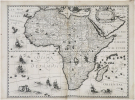
Carte de l'Asie corrigée, et augmentée, dessus toutes les aultres cy devant faictes par P. Bertius.
[Paris, Melchior Tavernier, 1632]. 377 x 498 mm.
Très belle et rare carte de l'Asie, dressée par Petrus Bertius, d'après la carte de Jodocus Hondius. Elle est issue de la première édition du Théâtre géographique du Royaume de France de Melchior Tavernier, publiée en 1632, avec le cartouche de l'adresse laissé vide. Elle a été gravée par Cornelis Danckerts. Elle est décorée de deux cartouches dont un cartouche de titre. L'Inde est ornée d'une vignette figurant un éléphant, le nord-est de l'Afrique de deux lions. Les mers sont décorées de quatre navires, de monstres marins, et d'un Neptune sonnant d'une conque marine. Cette rare carte fait partie d'un ensemble de cartes des quatre continents, publiées par Melchior Tavernier dans le Théâtre géographique du Royaume de France, une première fois en 1632, puis en 1634, 1637, 1638 et 1643. Né en Flandre en 1565, Petrus ou Pierre Bertius était un mathématicien et cartographe néerlandais. Obligé de fuir son pays en raison de troubles politiques et religieux, il s'installa à Paris, et fut nommé en 1618 cosmographe du roi Louis XIII. Graveur, imprimeur et hydrographe du roi, Melchior Tavernier, frère du célèbre voyageur Jean-Baptiste, fut à l'origine du développement de la cartographie française gravée du XVIIe siècle. Son Théâtre géographique du royaume de France est l'un des atlas français les plus importants du XVIIe siècle. Bel exemplaire. Pastoureau, Les Atlas français XVIe – XVIIe siècles, TAVERNIER II A, 3.
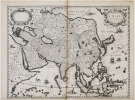
Petrus Kemme. Authors: FELT, Job Floris, Alice Haddad, Petrus Kemme, Jasper Stevens, Caroline Voet
Reference : 67219
Ten Scenographies. A Matter of Architecture F.E.L.T.
Antwerpen , VAi - Flanders Archit. Institute, 2025 Folded softcover, 138 pages, 33 x 22 cm, English text. *New. ISBN 9789492567390.
Over the past decade, scenography has been a fundamental part of FELT?s design practice. Understood here as exhibition designs, this type of commission has been a space of particular importance to try out and refine design ideas; where architectural scale meets the levity of smaller-scale design. At about one scenography per year, they have informed the breadth of FELT?s work, ranging from furniture design to representative urban architecture.
Le Lycanthrope, Champavert, sa vie son oeuvre...
BOREL (Pétrus) - MARIE (Aristide)Pétrus Borel, le Lycanthrope. Sa vie et son oeuvre suivi d'une bibliographie (Tome 1). Rhapsodies (Tome 2). Champavert, Contes immoraux (Tome 3).Paris, Editions de la Force française, Coll. Les romantiques, 1922. 3 vol. (29,7, x 23,6 cm), brochés, couvertures imprimées, (dos brunis), intérieurs bien frais, non rognés, 208 & 397 & 248 pp., Edition établie et annotée par Aristide Marie. Ouvrages illustrés de compositions gravées sur pierre d'André HoferBel exemplaire sur pur fil numéroté
Conradus de Strazburg, Iohannes de Sacrobosco, Petrus Cunestabulus, Petrus de Bernia, Radulphus de Longo Campo, Willelmus computista, auctores ignoti , Alfred Lohr (ed)
Reference : 66508
Opera de computo a tempore post Gerlandum usque ad Iohannem de Sacrobosco
, Brepols, 2025 Hardback, cxl + 788 pages, Size:155 x 245 mm, Illustrations:13 b/w, 26 tables b/w., Language(s):Latin, German. *new ISBN 9782503612003.
Summary Calendar calculations held a significant place in medieval education. They were used to determine movable feasts like Easter and Pentecost for a given year, calculate the day of the week for specific dates, and determine the moon's age, i.e., how many days had passed since the last new moon. Various tools were employed for these tasks, including key numbers for years, months, and festivals, calculation rules with or without the use of fingers, tables, and mnemonic verses. Given the importance of calendar calculations, it is not surprising that numerous contemporary texts comprehensively covered this subject. The current edition includes 15 texts from the period 1103 to 1232, 14 of which have not been printed before. Only the most successful of these texts, written by Johannes de Sacrobosco, was first printed in 1538 and subsequently in many other editions. The rich content of the texts published here is made accessible through several indexes, including an alphabetical subject index. Die Kalenderrechnung hatte im mittelalterlichen Unterricht ihren festen Platz. Mit ihr konnte man f r ein vorgegebenes Jahr die beweglichen Feste wie Ostern und Pfingsten bestimmen, aber auch beispielsweise ausrechnen, welchen Wochentag ein bestimmtes Datum hatte oder wie alt der Mond dann war, d.h. wie viele Tage seit dem letzten Neumond vergangen waren. F r diese Aufgaben wurden verschiedene Hilfsmittel eingesetzt. Es gab Kennzahlen f r Jahre, Monate und Feste, Rechenvorschriften mit oder ohne Zuhilfenahme der Finger, Tabellen und Merkverse. Bei dem hohen Stellenwert, den die Kalenderrechnung hatte, verwundert es nicht, dass zahlreiche zeitgen ssische B cher das Gebiet gesamthaft darstellten. Die vorliegende Edition enth lt 15 Texte aus der Zeit von 1103 bis 1232, von denen 14 bisher nicht gedruckt vorliegen. Lediglich der erfolgreichste dieser Texte, verfasst von Johannes de Sacrobosco, wurde erstmals 1538 und dann in vielen weiteren Auflagen gedruckt. Der reiche Inhalt der hier ver ffentlichten Texte wird durch mehrere Indizes erschlossen, zu denen insbesondere auch ein alphabetisches Sachregister geh rt. TABLE OF CONTENTS Vorwort Einleitung Zur Konzept des vorliegenden Buches Die Autoren und ihr Werke A: Ignoti auctoris Regulae factae de computo B: Ignoti auctoris Computus de sententiis doctorum collectus C: Ignoti auctoris Ars computi D: Ignoti auctoris Summa de computo ecclesiastico E: Magistri Willelmi Summa de computo F: Ignoti auctoris Tractatus de computo manuali G: Petri?Cunestabuli? De computo H: Ignoti auctoris Compendium de computo I: Ignoti auctoris Computus J: Conradi de Strazburg Computus K: Petri de Bernia Computus de arte astronomiae L: Radulfi de Longo Campo Computus M: Ignoti auctoris Computus N: Iohannis de Sacrobosco (?) Computus ecclesiasticus O: Iohannis de Sacrobosco Nova computi compilatio Fr here Ausgaben Editorische Grunds tze Handschriften Bibliographie Quellen Sekund rliteratur Textus Indices Index biblicus Index fontium Index uersuum Index nominum Index analyticus
PETRUS DAMIANUS sanctus O.S.B. [PETRUS DAMIANI, PETER DAMIAN] (LUCCHESI Ioannes, ed.)
Reference : R118850
(1983)
Sancti Petri Damiani Sermones (in: Corpus Christianorum, Continuatio Mediaevalis, 57)
Turnhout, Brepols 1983 lxiii + 492pp., 25cm., in the series "Corpus Christianorum Continuatio Mediaevalis" volume LVII (57), publisher's hardcover binding in orange cloth with gilt lettering, ISBN 2-503-03571-0, introduction and text in Latin, text is clean and bright, small exe-libris stamp on blanco endpaper and at verso of title page, good condition, weight: 1.1kg., R118850
Testimonia orationis Christianae antiquioris (dans: Corpus Christianorum, Continuatio Mediaevalis, 47)
Turnhout, Brepols 1977 xxxviii + 217pp. + 2 planches hors-texte, 25cm., dans la série "Corpus Christianorum Continuatio Mediaevalis" volume XLVII (47), reliure toile d'éditeur avec titre doré, ISBN 2-503-03471-3, introduction en français, texte en latin, texte frais, petit cachet ex-libris sur la feuille de garde blanche et au verso de la page de titre, sinon en très bon état, [contient: oratio sancti Brandani - Psalterium adbreviatum Vercellense - Liber sacramentorum excarsus - Liber sacramentorum Romane ecclesiae ordine exscarpsus), R118859
PETRUS PICTOR & PETRUS DE SANCTO AUDEMARO (& VAN ACKER L., ed.)
Reference : R67817
(1972)
Petri Pictoris Carmina nec non Petri de Sancto Audemaro Librum de coloribus faciendis [Corpus Christianorum. Continuatio Mediaevalis, 25] (Carmina nec non Petri de sancto Audemaro Liber de coloribus faciendis)
Turnhout, Brepols 1972 clxx + 247pp., 25cm., in the series "Corpus Christianorum. Continuatio Mediaevalis" volume XXV (25), publisher's hardcover binding in orange cloth with gilt lettering, text is clean and bright, very good condition, ISBN 2-503-03251-1, [introduction in German, text in Latin], R67817
 Write to the booksellers
Write to the booksellers


